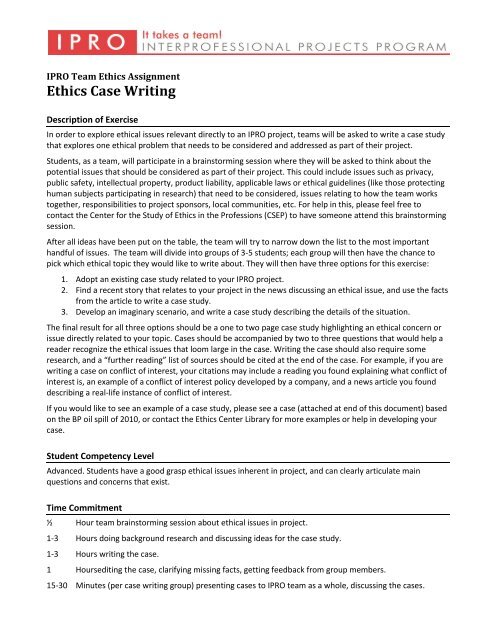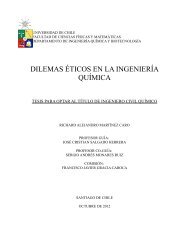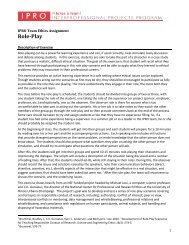Case Study Writing Assignment - Center for the Study of Ethics in the ...
Case Study Writing Assignment - Center for the Study of Ethics in the ...
Case Study Writing Assignment - Center for the Study of Ethics in the ...
Create successful ePaper yourself
Turn your PDF publications into a flip-book with our unique Google optimized e-Paper software.
IPRO Team <strong>Ethics</strong> <strong>Assignment</strong><strong>Ethics</strong> <strong>Case</strong> <strong>Writ<strong>in</strong>g</strong>Description <strong>of</strong> ExerciseIn order to explore ethical issues relevant directly to an IPRO project, teams will be asked to write a case studythat explores one ethical problem that needs to be considered and addressed as part <strong>of</strong> <strong>the</strong>ir project.Students, as a team, will participate <strong>in</strong> a bra<strong>in</strong>storm<strong>in</strong>g session where <strong>the</strong>y will be asked to th<strong>in</strong>k about <strong>the</strong>potential issues that should be considered as part <strong>of</strong> <strong>the</strong>ir project. This could <strong>in</strong>clude issues such as privacy,public safety, <strong>in</strong>tellectual property, product liability, applicable laws or ethical guidel<strong>in</strong>es (like those protect<strong>in</strong>ghuman subjects participat<strong>in</strong>g <strong>in</strong> research) that need to be considered, issues relat<strong>in</strong>g to how <strong>the</strong> team workstoge<strong>the</strong>r, responsibilities to project sponsors, local communities, etc. For help <strong>in</strong> this, please feel free tocontact <strong>the</strong> <strong>Center</strong> <strong>for</strong> <strong>the</strong> <strong>Study</strong> <strong>of</strong> <strong>Ethics</strong> <strong>in</strong> <strong>the</strong> Pr<strong>of</strong>essions (CSEP) to have someone attend this bra<strong>in</strong>storm<strong>in</strong>gsession.After all ideas have been put on <strong>the</strong> table, <strong>the</strong> team will try to narrow down <strong>the</strong> list to <strong>the</strong> most importanthandful <strong>of</strong> issues. The team will divide <strong>in</strong>to groups <strong>of</strong> 3-5 students; each group will <strong>the</strong>n have <strong>the</strong> chance topick which ethical topic <strong>the</strong>y would like to write about. They will <strong>the</strong>n have three options <strong>for</strong> this exercise:1. Adopt an exist<strong>in</strong>g case study related to your IPRO project.2. F<strong>in</strong>d a recent story that relates to your project <strong>in</strong> <strong>the</strong> news discuss<strong>in</strong>g an ethical issue, and use <strong>the</strong> factsfrom <strong>the</strong> article to write a case study.3. Develop an imag<strong>in</strong>ary scenario, and write a case study describ<strong>in</strong>g <strong>the</strong> details <strong>of</strong> <strong>the</strong> situation.The f<strong>in</strong>al result <strong>for</strong> all three options should be a one to two page case study highlight<strong>in</strong>g an ethical concern orissue directly related to your topic. <strong>Case</strong>s should be accompanied by two to three questions that would help areader recognize <strong>the</strong> ethical issues that loom large <strong>in</strong> <strong>the</strong> case. <strong>Writ<strong>in</strong>g</strong> <strong>the</strong> case should also require someresearch, and a “fur<strong>the</strong>r read<strong>in</strong>g” list <strong>of</strong> sources should be cited at <strong>the</strong> end <strong>of</strong> <strong>the</strong> case. For example, if you arewrit<strong>in</strong>g a case on conflict <strong>of</strong> <strong>in</strong>terest, your citations may <strong>in</strong>clude a read<strong>in</strong>g you found expla<strong>in</strong><strong>in</strong>g what conflict <strong>of</strong><strong>in</strong>terest is, an example <strong>of</strong> a conflict <strong>of</strong> <strong>in</strong>terest policy developed by a company, and a news article you founddescrib<strong>in</strong>g a real-life <strong>in</strong>stance <strong>of</strong> conflict <strong>of</strong> <strong>in</strong>terest.If you would like to see an example <strong>of</strong> a case study, please see a case (attached at end <strong>of</strong> this document) basedon <strong>the</strong> BP oil spill <strong>of</strong> 2010, or contact <strong>the</strong> <strong>Ethics</strong> <strong>Center</strong> Library <strong>for</strong> more examples or help <strong>in</strong> develop<strong>in</strong>g yourcase.Student Competency LevelAdvanced. Students have a good grasp ethical issues <strong>in</strong>herent <strong>in</strong> project, and can clearly articulate ma<strong>in</strong>questions and concerns that exist.Time Commitment½Hour team bra<strong>in</strong>storm<strong>in</strong>g session about ethical issues <strong>in</strong> project.1-3 Hours do<strong>in</strong>g background research and discuss<strong>in</strong>g ideas <strong>for</strong> <strong>the</strong> case study.1-3 Hours writ<strong>in</strong>g <strong>the</strong> case.1 Hoursedit<strong>in</strong>g <strong>the</strong> case, clarify<strong>in</strong>g miss<strong>in</strong>g facts, gett<strong>in</strong>g feedback from group members.15-30 M<strong>in</strong>utes (per case writ<strong>in</strong>g group) present<strong>in</strong>g cases to IPRO team as a whole, discuss<strong>in</strong>g <strong>the</strong> cases.
Tasks Involved<strong>Writ<strong>in</strong>g</strong> a good case study is <strong>of</strong>ten more difficult <strong>the</strong>n it first seems, so it pays to break down <strong>the</strong> work <strong>in</strong>to aseries <strong>of</strong> steps and perhaps even divide up <strong>the</strong>se steps among group members.1. Bra<strong>in</strong>storm. What ethical topics does your IPRO project <strong>in</strong>volve? Assign topics to groups <strong>of</strong> 3-5students.2. Research. What are some <strong>of</strong> <strong>the</strong> concerns surround<strong>in</strong>g your topic? Who are <strong>the</strong> stakeholders <strong>in</strong>volved?What laws, guidel<strong>in</strong>es or o<strong>the</strong>r standards govern how major problems or questions <strong>in</strong> this area shouldbe addressed?3. F<strong>in</strong>d examples. Locate some examples <strong>of</strong> case studies already written on your topic (see a collection<strong>of</strong> ethics case studies at http://ethics.iit.edu/eelibrary/), do some research <strong>in</strong> major newspapers andmagaz<strong>in</strong>es <strong>for</strong> stories cover<strong>in</strong>g your topic, or read some articles about your topic and beg<strong>in</strong> th<strong>in</strong>k<strong>in</strong>gwhat k<strong>in</strong>d <strong>of</strong> scenario you want to write.4. Bra<strong>in</strong>storm. Once you have an idea about <strong>the</strong> k<strong>in</strong>d <strong>of</strong> scenario with which you want to work, talk withyour team members and take notes. Who are <strong>the</strong> ma<strong>in</strong> protagonists <strong>in</strong> <strong>the</strong> story? What is <strong>the</strong> ethicalquestion or concern <strong>the</strong>y are fac<strong>in</strong>g? What are <strong>the</strong> surround<strong>in</strong>g details that complicate this situation?5. Write up <strong>the</strong> case. The case could be written about your IPRO, about a similar project, or be about asimilar topic but set <strong>in</strong> a completely different environment, such as <strong>in</strong> a workplace or a committeemeet<strong>in</strong>g. The important th<strong>in</strong>g is that <strong>the</strong> case highlights one or more aspects <strong>of</strong> your topic, though itcould <strong>in</strong>volve many issues, such as pr<strong>of</strong>essional responsibility, public safety, and employer/employeerelationships. If you are adapt<strong>in</strong>g a case, see if you can add details that make <strong>the</strong> case more relevant toyour IPRO project. For <strong>in</strong>stance, you may f<strong>in</strong>d a medical ethics case that can be adapted to look atethical responsibilities <strong>in</strong> eng<strong>in</strong>eer<strong>in</strong>g. If you are look<strong>in</strong>g at news articles, see if you can f<strong>in</strong>d one aspect<strong>of</strong> that real-life event to focus on, such as choices that need to be made by one <strong>in</strong>dividual or group <strong>of</strong><strong>in</strong>dividuals as <strong>in</strong> <strong>the</strong> BP case below.6. Edit<strong>in</strong>g and <strong>the</strong> review process. Have all <strong>the</strong> members <strong>of</strong> your group read <strong>the</strong> case and madesuggestions. Are <strong>the</strong>re crucial details miss<strong>in</strong>g? How can <strong>the</strong> case be reworked to help readers th<strong>in</strong>kabout <strong>the</strong> nuances <strong>of</strong> <strong>the</strong> ethical concern at hand? What k<strong>in</strong>ds <strong>of</strong> questions do you want to ask about<strong>the</strong> case? Feel free to contact <strong>the</strong> <strong>Ethics</strong> <strong>Center</strong> Library <strong>for</strong> help with this, along with help <strong>in</strong> f<strong>in</strong>d<strong>in</strong>greferences to <strong>in</strong>clude with <strong>the</strong> case.7. <strong>Case</strong> Discussion. Hand out copies <strong>of</strong> <strong>the</strong> case to your IPRO team, and hold a short discussion about <strong>the</strong>questions you ask about <strong>the</strong> case. Based on this, you may want to edit your case be<strong>for</strong>e you post <strong>the</strong>f<strong>in</strong>al version on <strong>the</strong> iGroups web site.Potential DeliverableAn ethics case study, one to two pages <strong>in</strong> length, <strong>in</strong>clud<strong>in</strong>g questions and cited sources. This deliverable can beuploaded to share.iit.edu by <strong>the</strong> deadl<strong>in</strong>e set each semester by <strong>the</strong> IPRO Program.
<strong>Case</strong> Example: BPA week after <strong>the</strong> British Petroleum oil spill <strong>in</strong> <strong>the</strong> Gulf <strong>of</strong> Mexico, you are hired by BP to act as a consultant on<strong>the</strong> cleanup <strong>of</strong> a section <strong>of</strong> <strong>the</strong> Louisiana coastl<strong>in</strong>e. At an early meet<strong>in</strong>g <strong>of</strong> <strong>the</strong> expert advis<strong>in</strong>g committee, one<strong>of</strong> your colleagues, Dr. Sanderson, suggests that dispersants can be used to help break up <strong>the</strong> dense oil that iscont<strong>in</strong>u<strong>in</strong>g to accumulate on <strong>the</strong> surface <strong>of</strong> <strong>the</strong> ocean and mak<strong>in</strong>g its way towards <strong>the</strong> shore. He suggestsus<strong>in</strong>g <strong>the</strong> product l<strong>in</strong>e Corexit, as BP already has a relationship with <strong>the</strong> manufacturer <strong>of</strong> this family <strong>of</strong>dispersants and can get a large amount <strong>for</strong> a reasonable price. He fur<strong>the</strong>r urges adopt<strong>in</strong>g this l<strong>in</strong>e <strong>of</strong> action as alarge amount <strong>of</strong> <strong>the</strong> chemical has already been shipped to o<strong>the</strong>r parts <strong>of</strong> Louisiana, so it is readily on hand. At<strong>the</strong> end <strong>of</strong> <strong>the</strong> meet<strong>in</strong>g, all <strong>the</strong> committee members agree that rapid action is needed, as <strong>the</strong> oil is quicklymov<strong>in</strong>g closer to <strong>the</strong> shorel<strong>in</strong>e.That even<strong>in</strong>g, you talk about this situation with a friend <strong>of</strong> yours, an environmental scientist who expressed<strong>in</strong>terest <strong>in</strong> your work on <strong>the</strong> oil spill. When she hears that your committee is th<strong>in</strong>k<strong>in</strong>g about recommend<strong>in</strong>gCorexit, she warns you that <strong>the</strong> product l<strong>in</strong>e is no longer approved <strong>for</strong> use <strong>in</strong> Brita<strong>in</strong> because laboratory testsfound <strong>the</strong> dispersant harmful to sea life that <strong>in</strong>habits rocky shores. The next day you do some research and talkto a representative from Nalco Corporation, <strong>the</strong> manufacturer <strong>of</strong> Corexit who tells you that <strong>the</strong>se f<strong>in</strong>d<strong>in</strong>gslikely have no relevance <strong>in</strong> <strong>the</strong> current situation, as <strong>in</strong> Louisiana <strong>the</strong> dispersant will be used <strong>in</strong> <strong>the</strong> open sea, noton <strong>the</strong> shore. However, you are worried about <strong>the</strong> sheer amount <strong>of</strong> <strong>the</strong> dispersant that is go<strong>in</strong>g to be used,and that some <strong>of</strong> it might get to <strong>the</strong> shorel<strong>in</strong>e. The representative tells you that this should not be a problemand directs you to <strong>the</strong> safety <strong>in</strong><strong>for</strong>mation sheets on Corexit available <strong>of</strong>f <strong>of</strong> <strong>the</strong> Nalco web site. When read<strong>in</strong>g<strong>the</strong>se sheets, you f<strong>in</strong>d out that a number <strong>of</strong> <strong>the</strong> <strong>in</strong>gredients <strong>in</strong> <strong>the</strong> dispersant are labeled as “proprietary”. In ananswer to an email you send, <strong>the</strong> Nalco representative tells you that some <strong>in</strong>gredients are listed as proprietaryto protect <strong>the</strong> company’s trade secrets.The next day, you communicate all <strong>of</strong> this <strong>in</strong><strong>for</strong>mation to your fellow committee members by email, know<strong>in</strong>gthat you have a second meet<strong>in</strong>g scheduled <strong>in</strong> two days time. At this meet<strong>in</strong>g, <strong>the</strong> expert committee is go<strong>in</strong>g tohave to decide on what recommendation to make.QuestionsWho are <strong>the</strong> major stakeholders <strong>in</strong> this situation?What problems is <strong>the</strong> proprietary nature <strong>of</strong> some <strong>of</strong> <strong>the</strong>se <strong>in</strong>gredients <strong>in</strong> Corexit likely to pose? Is Nalcoethically justified <strong>in</strong> keep<strong>in</strong>g <strong>the</strong>se <strong>in</strong>gredients secret?As a committee member, whose <strong>in</strong>terests should you be represent<strong>in</strong>g? What are <strong>the</strong> major factors andconcerns you need to consider and communicate to your fellow committee members?What recommendation should <strong>the</strong> committee make, and why? Be sure to justify your answer.References<strong>Case</strong> based on facts drawn from New York Times article,”In Gulf <strong>of</strong> Mexico, Chemicals Under Scrut<strong>in</strong>y.“ May 5,2010. Elisabeth Rosenthal. http://www.nytimes.com/2010/05/06/science/earth/06dispersants. htmlNalco. “COREXIT Technology”. Nalco North American Web site. 2010. Last viewed December 10, 2010.http://www.nalco.com/applications/corexit-technology.htmWeil, Vivian and John W. Snapper (1989). Own<strong>in</strong>g Scientific and Technical In<strong>for</strong>mation: Values and EthicalIssues. New Brunswick, Rutgers University Press. pp. 3-9.©<strong>Center</strong> <strong>for</strong> <strong>the</strong> <strong>Study</strong> <strong>of</strong> <strong>Ethics</strong> <strong>in</strong> <strong>the</strong> Pr<strong>of</strong>essions, Ill<strong>in</strong>ois Institute <strong>of</strong> Technology. Can be used with properacknowledgements <strong>for</strong> educational purposes.





